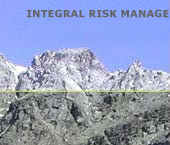| |
The goal of WP4 was: (1) To assess property damage and human losses due to debris flows, rock avalanches, and snow avalanches in selected alpine villages and
regions; (2) to derive a catalogue of indicators for quantifying technical,
socio-economic, and ecological vulnerability to these processes; and (3) to provide a simple means for weighting and merging these various types of
vulnerability for integration into the risk equation.
Vulnerability is a measure of the impact or the consequences of a natural hazard event on various elements at risk. These elements can be people, built structures, infrastructure or even entire communities. As such, they need to be addressed from a sociological as well as from a technical or economic perspective. The present work package focusses on technical and economic aspects in assessing vulnerability to torrent events and avalanches. The focus was on taking an economic perspective to develop an object-based vulnerability function with respect to torrent events and avalanches, and on taking a technical perspective to assess the structural resilience of values at risk. Local structural protection, such as reinforced concrete constructions, has a major influence on decreasing vulnerability.
In this work package a catalogue of vulnerable elements in mountain areas was compiled. An overview and critical assessment of existing vulnerability functions was elaborated for the processes snow avalanches,
|
|
rock avalanches and debris flows. In this context, vulnerability to rock avalanches is easiest to quantify: the coincidence of a rock avalanche with values at risk results in a complete destruction of objects such as buildings or infrastructure.
Several case studies have been carried out with respect to numerical and empirical modelling of vulnerability. A series of empirical vulnerability functions describing the potential harm to both people and buildings exists. Most of these functions suffer from being based on insufficient data. It is therefore hard to generalize them as they apply to the situation for which they were elaborated. To overcome this problem, we followed an alternative approach in IRASMOS, attempting to evaluate the destructive force of a snow avalanche on a building using 3D numerical computer simulations and a structural damage index.
All of these approaches contribute a piece to a puzzle. However, there is still considerable need for future research, in particular to unify and reconcile these different approaches and to apply them in the analysis of multi-risk situations, where even less data are available. The goal should be to arrive at representative standardized scenarios, allowing for the derivation of vulnerability functions that depend on as few variables as possible.
|

